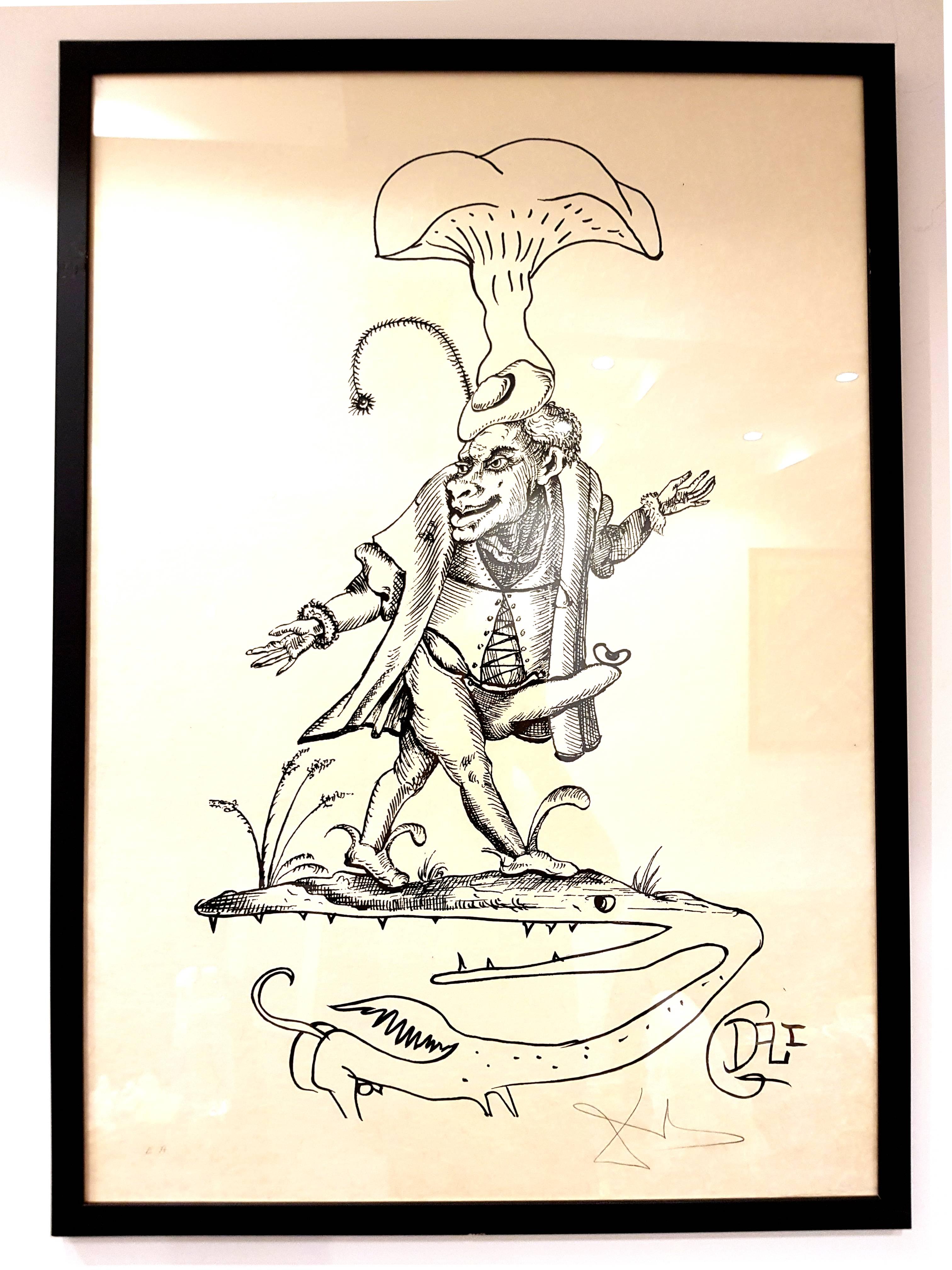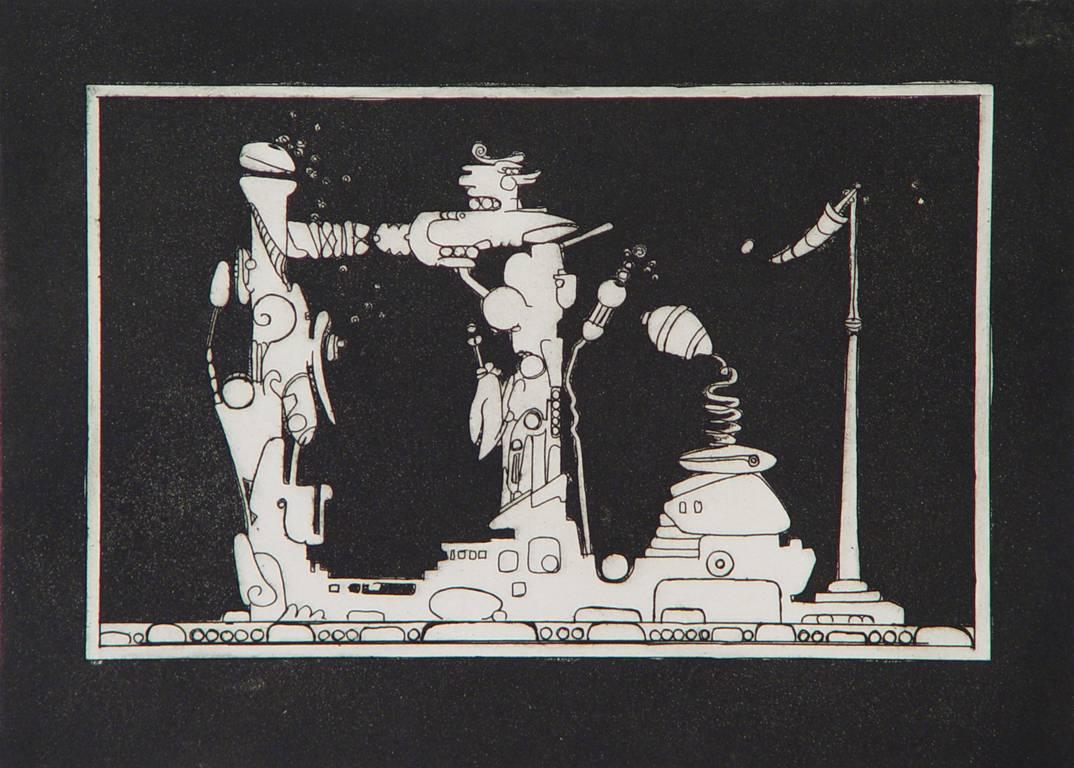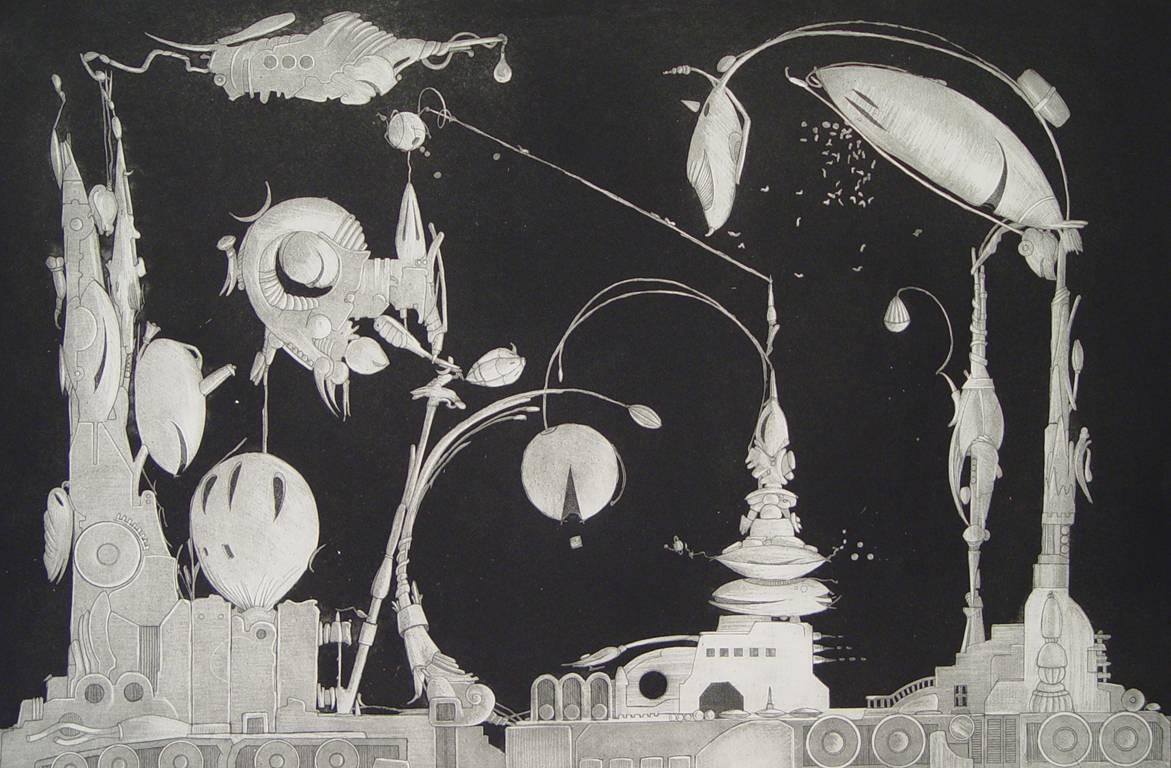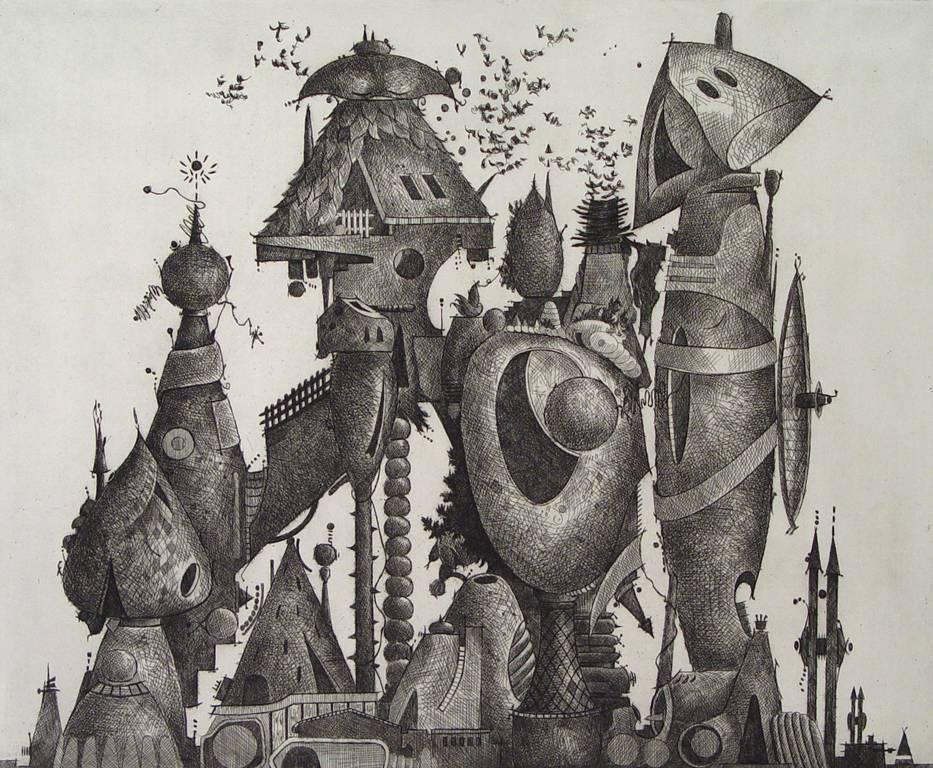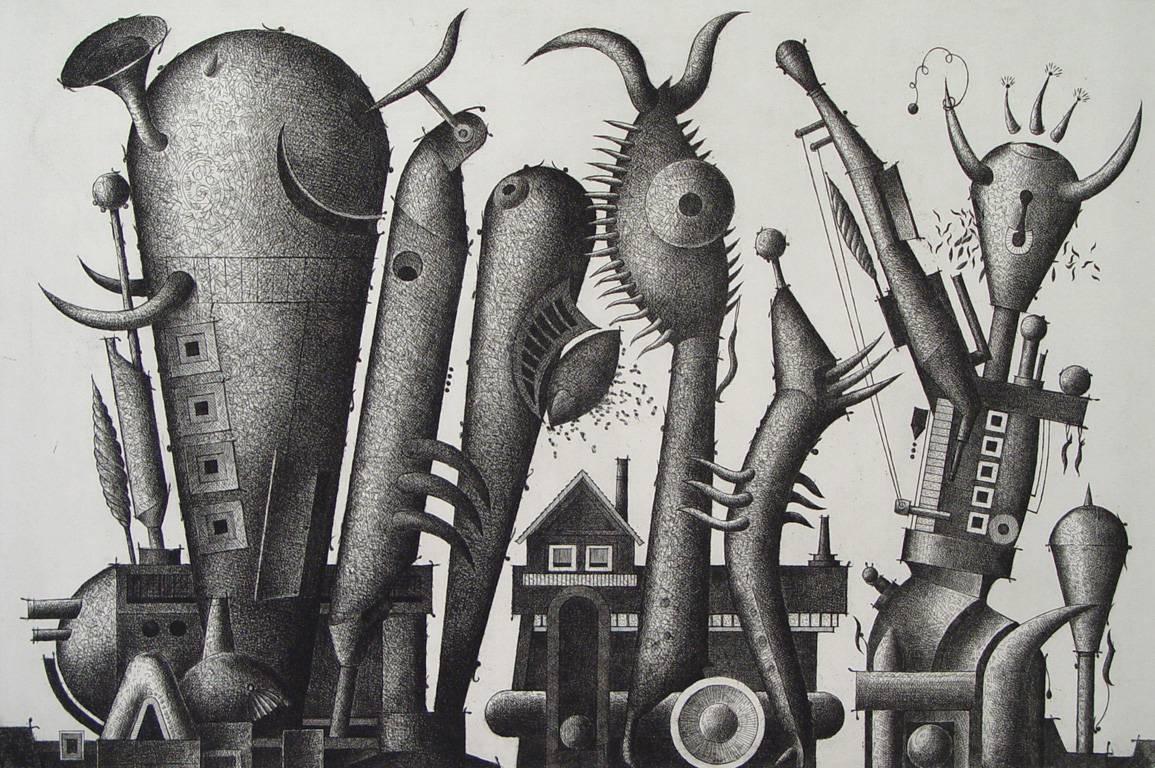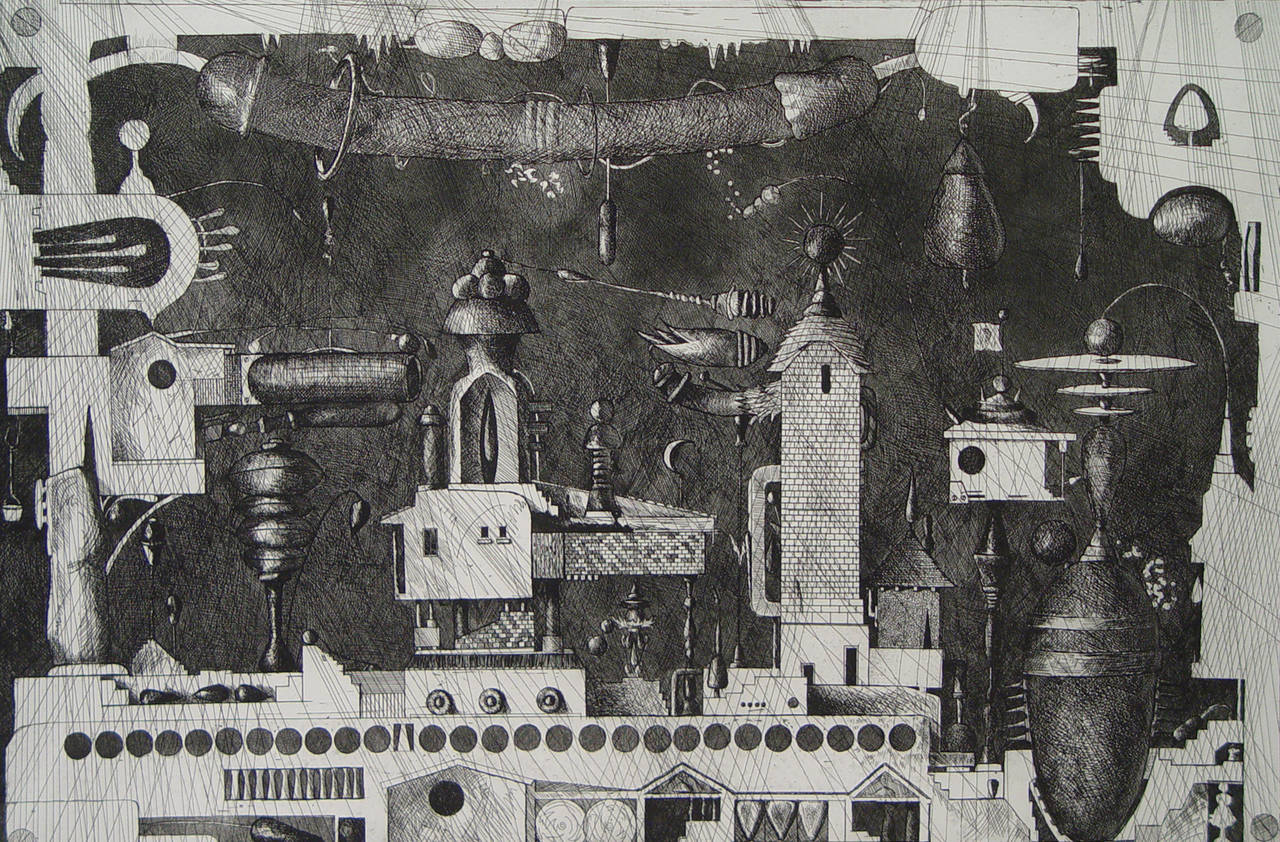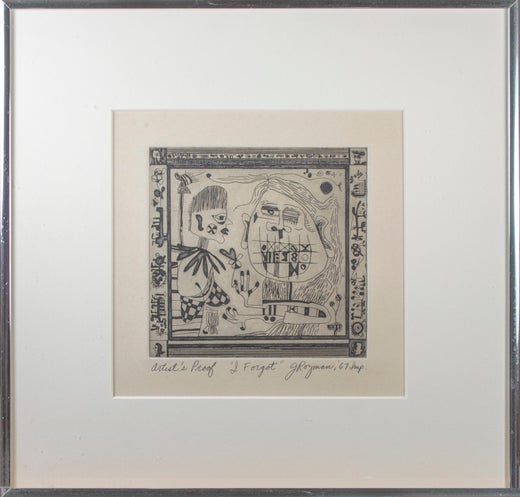Joseph Rozman"Double Landscape, " Black & White Two-plate Landscape Etching by Joseph Rozman1965
1965
About the Item
- Creator:
- Creation Year:1965
- Dimensions:Height: 11.625 in (29.53 cm)Width: 12.375 in (31.44 cm)
- Medium:
- Movement & Style:
- Period:
- Condition:
- Gallery Location:Milwaukee, WI
- Reference Number:
Joseph Rozman
Joseph Rozman was born on December 26, 1944, in Milwaukee, Wisconsin. He was the first artist to have a solo exhibition at the David Barnett Gallery in 1967, 1969 and again in 1971. Rozman received his BFA with honors in 1967 and MFA in 1969 from the University of Wisconsin-Milwaukee. He later became a professor at Mount Mary College. His zany style portrays his spontaneous blending of ancient and personal symbols influenced by Egyptian art and the paintings and drawings of Paul Klee, his free experimentation with varied materials and processes, and his delight in color and texture. Carrying the credo of "Art is fun," Rozman's playful gestures recur in his richly diverse works.
- ShippingRetrieving quote...Ships From: Milwaukee, WI
- Return PolicyA return for this item may be initiated within 14 days of delivery.
- "La Bataille de l'Argonne (The Battle of Argonne), " Litho after Rene MagritteBy René MagritteLocated in Milwaukee, WI"La Bataille de l'Argonne (The Battle of Argonne)" is a color lithograph after the original 1959 painting by Rene Magritte. The landscape is shrouded by the mist of twilight. A cresc...Category
2010s Surrealist Landscape Prints
MaterialsLithograph
- "Le Dernier Cri (The Last Word), " Lithograph after the Painting by Rene MagritteBy René MagritteLocated in Milwaukee, WI"Le Dernier Cri (The Last Word)" is a color lithograph after original 1967 painting by Rene Magritte. A huge leaf levitates in the middle of a mountain view. A fully grown tree is pa...Category
2010s Surrealist Landscape Prints
MaterialsLithograph
- "La Bataille de l'Argonne (The Battle of Argonne), " Litho after Rene MagritteBy René MagritteLocated in Milwaukee, WI"La Bataille de l'Argonne (The Battle of Argonne)" is a color lithograph after the original 1959 painting by Rene Magritte. The landscape is shrouded by ...Category
2010s Surrealist Landscape Prints
MaterialsLithograph
- "Le Retour (Return), " Color Lithograph after Painting by Rene MagritteBy René MagritteLocated in Milwaukee, WI"Le Retour (Return)" is a color lithograph after the original 1940 painting by Rene Magritte. A bird which is really just the sky in the day and clouds. A nest bellow the bird has th...Category
Early 2000s Surrealist Landscape Prints
MaterialsLithograph
- "L'Entree en scene (The Emergence), " Color Lithograph after Rene MagritteBy René MagritteLocated in Milwaukee, WI"L'Entree en scene (The Emergence)" is a color lithograph after a 1961 original piece by Rene Magritte. A transparent bird flies over the ocean. The body of this bird shows through it a clean light sky with fluffy clouds. The view around the bird is instead the dark night, stars shine at the top of the scene. Clouds blow by and the waves are turbulent. Art: 12.13 x 9.75 in Frame: 22.75 x 20.38 in René-François-Ghislain Magritte was born November 21, 1898, in Lessines, Belgium and died on August 15, 1967 in Brussels. He is one of the most important surrealist artists. Through his art, Magritte creates humor and mystery with juxtapositions and shocking irregularities. Some of his hallmark motifs include the bourgeois “little man,” bowler hats, apples, hidden faces, and contradictory texts. René Magritte’s father was a tailor and his mother was a miller. Tragedy struck Magritte’s life when his mother committed suicide when he was only fourteen. Magritte and his two brothers were thereafter raised by their grandmother. Magritte studied at the Brussels Academy of Fine Arts from 1916 to 1918. After graduating he worked as a wallpaper designer and in advertisement. It was during this period that he married Georgette Berger, whom he had known since they were teenagers. In 1926, René Magritte signed a contract with the Brussels Art Gallery, which allowed him to quit his other jobs and focus completely on creating art. A year later he had his first solo show at the Galerie la Centaurie in Brussels. At this show Magritte exhibited what is today thought of as his first surrealist piece, The Lost Jockey, painted in 1926. In this work a jockey and his steed run across a theater stage, curtains parted on either side. Throughout the scene, there are trees with trunks shaped somewhat like chess pawns with musical scores running vertically up their sides and branches sticking out from all angles. Critics did not enjoy this style of art; it was new, different, and took critical thought to understand, but The Lost Jockey was only the first of many surrealist artworks Magritte would paint. Because of the bad press in Brussels, René and Georgette moved to Paris in 1927, with the hope that this center of avant-garde art would bring him success and recognition. In Paris, he was able to become friends with many other surrealists, including André Breton and Paul Éluard. They were able to learn from and inspire one another, pushing the Surrealist movement further forward. It was also in Paris that Magritte decided to add text to some of his pieces, which was one of the elements that made his artwork stand out. In 1929, he painted one of his most famous oil works: The Treachery of Images. This is the eye-catching piece centered on a pipe. Below the pipe is written “Ceci n’est pas un pipe,” which translates to “This is not a pipe.” This simple sentence upset many critics of the time, for of course it was a pipe. Magritte replied that it was not a pipe, but a representation of a pipe. One could not use this oil on canvas as a pipe, to fill it with tobacco and smoke it. Thus, it was not a pipe. In 1930, Magritte and Georgette moved back to Brussels. Though they would travel to his exhibitions elsewhere, their home going forward would always be in Brussels. Magritte had his first American exhibition at the Julien Levy Gallery in New York City in 1936 and his first show in England two years later in 1938 at The London Gallery...Category
2010s Surrealist Landscape Prints
MaterialsLithograph
- "La Fleche de Zenon (Zeno's Arrow), " Lithograph after Painting by Rene MagritteBy René MagritteLocated in Milwaukee, WI"La Fleche de Zenon (Zeno's Arrow)" is a color lithograph after the original 1964 painting by Rene Magritte. A gigantic rock levitates over the sea. Waves crash bellow and a crescent moon hangs above. Art: 9.75 x 11.75 in Frame: 20.38 x 22.38 in René-François-Ghislain Magritte was born November 21, 1898, in Lessines, Belgium and died on August 15, 1967 in Brussels. He is one of the most important surrealist artists. Through his art, Magritte creates humor and mystery with juxtapositions and shocking irregularities. Some of his hallmark motifs include the bourgeois “little man,” bowler hats, apples, hidden faces, and contradictory texts. René Magritte’s father was a tailor and his mother was a miller. Tragedy struck Magritte’s life when his mother committed suicide when he was only fourteen. Magritte and his two brothers were thereafter raised by their grandmother. Magritte studied at the Brussels Academy of Fine Arts from 1916 to 1918. After graduating he worked as a wallpaper designer and in advertisement. It was during this period that he married Georgette Berger, whom he had known since they were teenagers. In 1926, René Magritte signed...Category
2010s Surrealist Landscape Prints
MaterialsLithograph
- Salvador Dali - Les Songes Drolatiques - Handsigned LithographBy Salvador DalíLocated in Collonge Bellerive, Geneve, CHHand-Signed Lithograph by Salvador Dali Japan Paper Title: Pantagruel's Dreams Signed in Pencil by Salvador Dali Dimensions: 76 x 56 cm Edition: EA 1973 References : Field 73-7 (p. 1...Category
1970s Surrealist Figurative Prints
MaterialsEtching
- Rear Section of BBy Valton TylerLocated in Dallas, TXIn The New York Times Arts in America column, Edward M. Gomez writes of Valton Tyler, "visionary seems the right word for describing his vivid, unusual and technically refined painti...Category
Late 20th Century Surrealist Prints and Multiples
MaterialsEtching, Aquatint
- Front Elevation of Section 17By Valton TylerLocated in Dallas, TXIn The New York Times Arts in America column, Edward M. Gomez writes of Valton Tyler, "visionary seems the right word for describing his vivid, unusual and technically refined paintings, prints and drawings, whose style defies convenient labels. Abstract, surreal, cartoonish, sci-fi fantastic, metaphysical, apocalyptic-Baroque - all of these fit but also fall short of fully describing his art." (The Living Arts, June 13, 2000, p. B2) Valton Tyler was born in 1944 in Texas, where "the industrial world of oil refineries made a long-lasting impression on Valton as a very young child living in Texas City." (Reynolds, p. 25) After leaving Texas City, Valton made his way to Dallas, where he briefly enrolled at the Dallas Art Institute, but found it to be too social and commercial for his taste. After Valton's work was introduced to Donald Vogel (founder of Valley House Gallery), "Vogel arranged for Tyler to use the printmaking facilities in the art department of the Southern Methodist University in Dallas, where the young artist essentially taught himself several demanding printmaking techniques. 'It was remarkable,' Vogel says. 'Not only did he learn complicated etching methods, but he was able to express himself powerfully in whatever medium he explored.' Vogel became the publisher of Tyler's prints. Among them, the artist made editions of some 50 different images whose sometimes stringy abstract forms and more solid, architecturally arresting elements became the precursors of his later, mature style." (Gomez, Raw Vision #35, p. 36) "Front Elevation of Section 17" is plate number 34, and is reproduced in "The First Fifty Prints: Valton Tyler" with text by Rebecca Reynolds, published for Valley House Gallery by Southern Methodist University Press, Dallas, Texas, 1972. In "The First Fifty Prints," Reynolds writes, “this plate can be seen as a culmination of the artist’s earlier uses of aquatint and as a new direction the artist will take in his compositions. In early plates such as ‘Joy,’ Plate No. 12, and ‘Do Not Touch,’ Plate No. 20, the artist has presented his designs to our unaccustomed eyes, either formally, by placing them on sculpture pedestals, or more abstractly, using smaller soft ground silhouettes. In later examples such as ‘One Little Stage,’ Plate No. 24, or ‘Heritage,’ Plate No. 25, we were brought closer to a direct interaction with the forms as they began to fill the plates with increasing sculptural and monumental qualities. It was still possible to maintain a more passive point of view because of the stage format of the compositions. In ‘Avenue 11,’ Plate No. 26, as we have seen, the artist unveils the true authority of his designs by placing them in our environment to compete with our reality of a familiar cityscape and to make us question our ideas of aesthetics and logic. In ‘Front Elevation’ we enter into and are confronted with these structures in their own massive landscape...Category
1970s Surrealist Prints and Multiples
MaterialsEtching, Rag Paper, Aquatint
- We're All HereBy Valton TylerLocated in Dallas, TXIn The New York Times Arts in America column, Edward M. Gomez writes of Valton Tyler, "visionary seems the right word for describing his vivid, unusual and technically refined painti...Category
1970s Surrealist Figurative Prints
MaterialsRag Paper, Etching
- SpindlesBy Valton TylerLocated in Dallas, TXIn The New York Times Arts in America column, Edward M. Gomez writes of Valton Tyler, "visionary seems the right word for describing his vivid, unusual and technically refined painti...Category
1980s Surrealist Landscape Prints
MaterialsRag Paper, Etching
- Night ShiftBy Valton TylerLocated in Dallas, TXIn The New York Times Arts in America column, Edward M. Gomez wrote of Valton Tyler, "visionary seems the right word for describing his vivid, unusual and technically refined paintin...Category
1970s Surrealist Still-life Prints
MaterialsRag Paper, Etching, Aquatint
